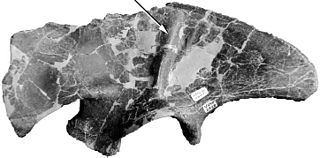Zofiabaatar is a genus of extinct mammal from the Upper Jurassic period. It was a relatively early member of the extinct order Multituberculata within the suborder "Plagiaulacida". It lived in North America along with dinosaurs such as Diplodocus and Allosaurus.

Stokesosaurus is a genus of small, carnivorous early tyrannosauroid theropod dinosaurs from the late Jurassic period of Utah, United States.

The Morrison Formation is a distinctive sequence of Late Jurassic sedimentary rock that is found in the western United States, which has a wide assortment of taxa represented in its fossil record, including dinosaur fossils in North America. It is composed of mudstone, sandstone, siltstone and limestone and is light grey, greenish gray, or red. Most of the fossils occur in the green siltstone beds and lower sandstones, relics of the rivers and floodplains of the Jurassic period.
Amphidon is an extinct genus of Late Jurassic mammal from the Morrison Formation. It is present in stratigraphic zone 5. The only species in the genus is Amphidon aequicrurius, found by Simpson in 1925.
Priacodon is an extinct genus of Late Jurassic eutriconodont mammal from the Alcobaça Formation of Portugal and the Morrison Formation of the midwestern United States. It is present in stratigraphic zones 4–6 of the latter. The genus contains four known species: Priacodon ferox, Priacodon fruitaensis, Priacodon lulli and Priacodon robustus.
Trioracodon is an extinct genus of Late Jurassic to Early Cretaceous eutriconodont mammal found in North America and the British Isles. It was named in 1928
Comodon is an extinct genus of Late Jurassic mammal from the Morrison Formation of Wyoming. Fossils of this taxon are present in stratigraphic zone 5.
Triconolestes is an extinct genus of Late Jurassic eutriconodont mammal from the Morrison Formation, present in stratigraphic zones 4. Known from only a single molar, it is a small mammal typically considered an amphilestid. However, it has also been compared to Argentoconodon, which has been considered a volaticothere related to gliding mammals such as Volaticotherium and Ichthyoconodon.
Tinodon is an extinct genus of mammal alive 155-140.2 million years ago (Oxfordian-Berriasian) which has been found in the Morrison Formation, the Alcobaça Formation (Portugal) and the Lulworth Formation (England). It is of uncertain affinities, being most recently recovered as closer to therians than eutriconodonts but less so than allotherians. Two species are known: T. bellus and T. micron.
Amblotherium is an extinct genus of Late Jurassic and Early Cretaceous mammal. The type species Amblotherium pusillum is from the Lulworth Formation of southern England, while the referred species Amblotherium gracile is from stratigraphic zones 2, 3 and 5 of the Morrison Formation of the US.

Paurodon is an extinct genus of Late Jurassic mammal from the Morrison Formation of the Western United States.
Tathiodon is an extinct genus of Late Jurassic mammal from the Morrison Formation. Present in stratigraphic zone 5.

Laolestes is an extinct genus of dryolestid mammal. Remains are known from the Morrison Formation, in stratigraphic zones 5 and 6., the Late Jurassic of Portugal, and Early Cretaceous Wadhurst Clay of UK.

Dryolestes is an extinct genus of Late Jurassic mammal from the Morrison Formation and the Alcobaça Formation of Portugal. The type species Dryolestes priscus is present in stratigraphic zones 2, 5, and 6.
Comotherium is an extinct genus of Late Jurassic mammal from the Morrison Formation. Present in stratigraphic zone 5.
Euthlastus is an extinct genus of Late Jurassic mammal from the Morrison Formation. Present in stratigraphic zones 5 and 6. It is represented by only five upper molars.
Theretairus is a Late Jurassic genus of sphenodont reptile from the Morrison Formation of western North America, present in stratigraphic zones 5 and 6.
Schillerosaurus was a genus of prehistoric lizard of the Late Jurassic Morrison Formation of Western North America.
Saurillodon is a genus of prehistoric lizard of the Late Jurassic of Portugal, UK and Morrison Formation of Western North America.
Parviraptor is a genus of stem-snake containing one species, Parviraptor estesi, from the Late Jurassic (Tithonian) or Early Cretaceous (Berriasian) Purbeck Limestone Formation of Dorset, England. A second species, Parviraptor gilmorei, was described from the Late Jurassic Morrison Formation of Western North America; it was present in stratigraphic zone 4. However, the second species was subsequently transferred to a separate genus Diablophis. An indeterminate species is known from the Bathonian aged Kirtlington Mammal Bed.











